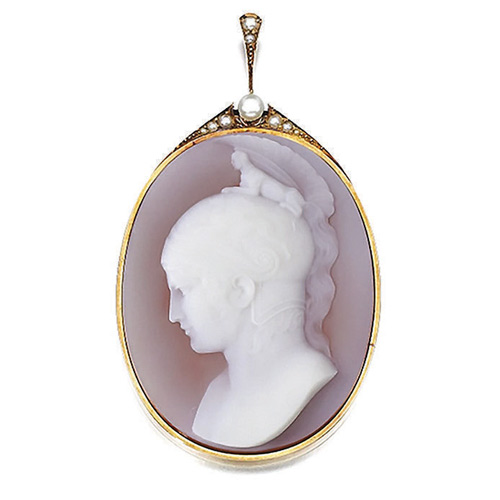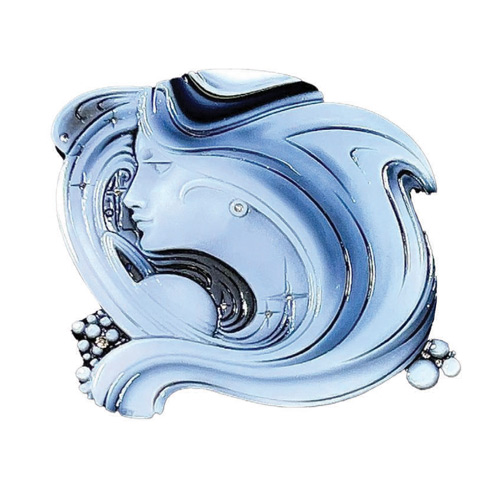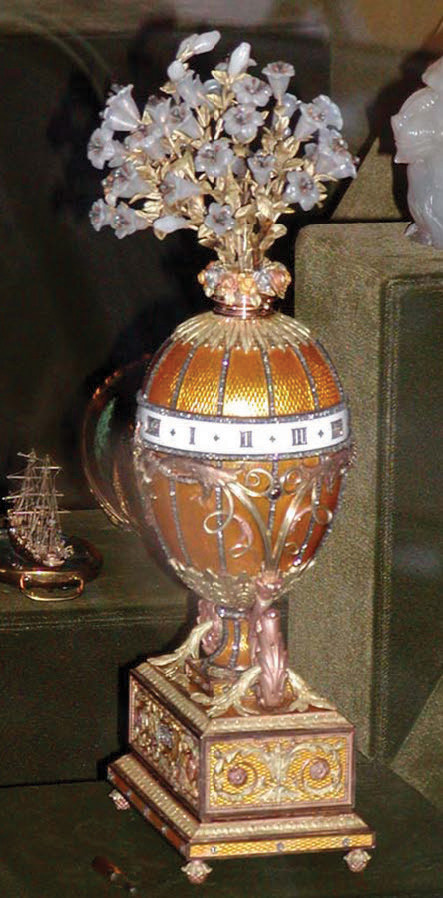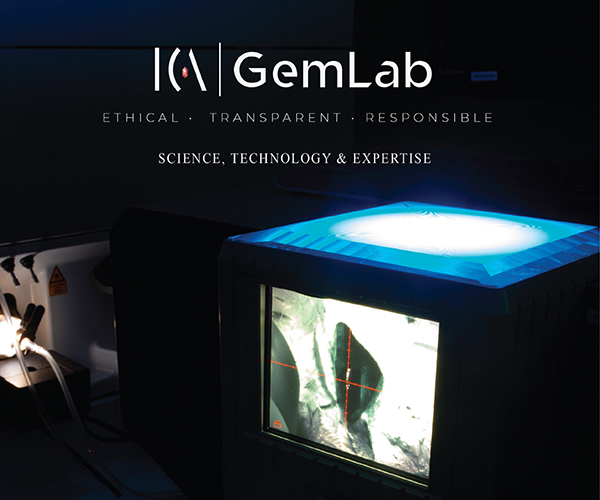Germany’s picturesque town of Idar-Oberstein stands as a beacon of excellence in the world of gemstones. Renowned not only for its gem cutting and trading, this vibrant locale is also celebrated for its very rich tradition of Steinschneidekunst – stone cutting art, featuring all kinds of glyptic art: cameos, intaglios, small and large sculptures, objets d’art and coats-of arms carvings. Many of the world’s most acclaimed carvers also learned their trade from the world-class carvers in Idar-Oberstein. This article offers a glimpse into some of the artisans and their remarkable art forms crafted in Idar-Oberstein.
Gemstone carvings have captivated humanity for millennia, going back thousands of years to ancient civilizations. This unique form of glyptic art, which encompasses the carving and engraving of various gemstones, has evolved significantly over the centuries, reflecting the ingenuity and creativity of its artisans.
A Bit of History
The origins of gemstone carving can be traced to early Mesopotamia, around 7000 years ago, where the Sumerians, Babylonians and Assyrians began crafting simple seals. Using rudimentary techniques, they etched geometric motifs – such as stars and zigzags – into materials like wood and bone, later transitioning to burned clay. The first notable examples of carved seals made from harder materials, such as sandstone and marble, emerged some 5000 years ago. Approximately 2000 years later, the ancient Greeks began producing intricate carvings from softer gemstones, including lapis lazuli and turquoise. The introduction of the engraving spindle, a couple of hundred years later, marked a significant advancement, enabling artisans to work with gemstones of greater hardness.

From Paris to Idar-Oberstein
The 19th century heralded a new era for gemstone carving, particularly in the Idar-Oberstein region. According to Ernst Falz (1939), the first cameo carver from the Idar-Oberstein area (Bruchweiler) was Georg Weismüller (1811-1851). In 1830, he traveled to Paris to hone his craft and, throughout the 1840s and 1850s, many young talents from Idar-Oberstein sought training in the French capital.
This period coincided with the influx of Brazilian agates, which were skillfully enhanced with vibrant colors due to their unique striped gray-white material whose layers of different fiber densities took on different hues. Consequently, large quantities of cameos and intaglios were produced.
Some of the artists working in Paris were Christian Cäsar, Louis Schmidt, Louis Purpur, Fritz Heidt, Wilhelm Leyser, Julius Schmidt, Charles Wild “neveu” and Jacob Wild “Graveur Wilde.” Because of the French-German war in 1870-1871, nearly all moved back to Idar- Oberstein. Paris times were over.
The artistic collaboration among rough stone dealers, stone cutters, goldsmiths, and enamelers in Idar-Oberstein led to its establishment as a global center for gemstone carving starting in 1880.
Important Carvers of the 19th and 20th Centuries
As the gemstone carving industry flourished, several notable artists emerged. Among them were Otto Minn (1896-1958), Paul Krieger (1903-2000), Carl August Schmelzer (1882-1955), Richard H. Hahn (1917-1999), who had a special exhibition of his carvings in 1973- 1974 in the German Gemstone Museum, and August Rudolf Wild (1891-1956), who had a special memorial exhibition at the same museum in 1983.


August Rudolf Wild was probably the most influential carver of his generation and is counted among the last masters of the art of cameo engraving. Despite the mounting economic and political problems of his era, Wild’s talents in gem carving did not go unrecognized. He won three Grand Prix at the 1937 Paris World’s Fair for his remarkable double-head carving of Ares and Demeter, his red-white cameo Winner and his blackand- white Fairytale. He refused however to attend the fair due to the organizing influence of the Nazi party at this event and his disagreement with their suppression and destruction of what they deemed degenerate art. Wild’s gem carving career was cut short in 1942 due to health issues.
More recently, artists such as Heinz Postler and, especially, Erwin Pauly further shaped the modern landscape of gemstone carving. Pauly is considered the grand seigneur of the famous Pauly family now in its third generation of gem carvers. Erwin Pauly was honored with the Federal Cross of Merit in 2019 for his lifetime achievements in the field.
The Fabergé Connection

The finest Fabergé carvings were sold from 1872 to 1917 in exquisite jewelry stores in Saint Petersburg and Moscow, as well as in London, Odessa and Kyiv. Some original objets d’art were crafted in Idar-Oberstein using materials such as nephrite and lapis lazuli, among others, while many Fabergé reproductions were later produced there.
Peter Carl Fabergé (1846-1920) spent several years in Germany before returning to the St. Petersburg Hermitage. In the late 1890s, he visited Idar-Oberstein multiple times, bringing design models of his carvings for production, particularly to the Elias Wolff and Gebr. Stern companies. After the Russian Revolution in 1917, Fabergé’s business came to an abrupt end. His company and workshops were expropriated, forcing him to emigrate.
Among Fabergé’s most remarkable and famous objets d’art were the stunning Fabergé eggs, many crafted as gifts for Russian Empress Maria Feodorovna.
After World War II, Idar-Oberstein companies, among them Wilhelm Dreher, Robert Juchem, and Richard Becker, began producing carvings reminiscent of Fabergé’s work (known as Fabergé-Art), focusing on flowers, leaves, and small to large animals, primarily in rock crystal and jasper. The enterprises of Georg O. Wild and Emil Becker were also involved in this revival.
The New Generation
Today, the tradition of gemstone carving continues with a new generation of artisans committed to preserving and evolving the craft. The following are only a few representative examples of the art of carving in Idar-Oberstein.
Andreas Roth. Born in 1973 in Idar-Oberstein, Andreas Roth followed in the footsteps of his father, Hans-Dieter Roth, an esteemed master gem carver. After completing his training from 1989 to 1993, Andreas earned his master’s degree in gem cutting and carving in 1999. Both father and son specialized in creating large cameos and unique engravings, portrait engravings and unusual gemstone objects. In 2004, father and son exhibited in Kofu, Japan and several national and international exhibitions followed. A couple of years ago, Dieter Roth sadly passed away.
Among Roth´s most stunning creations are the huge cameos paying homage to the Bible (1986-1998), William Shakespeare (2003-2008) and to Goethe´s Faust I and Faust II (2007-2012). The largest of Andrea’s two Faust carvings, a remarkable two-sided cameo measuring 46 x 37 cm, took more than 2000 hours of meticulous work.
Andreas Roth feels committed to the tradition, influenced especially by the master gemstone engravers Richard Hahn and August Rudolf Wild, explaining that he wants to continue his work successfully in the spirit of his predecessors.


Michael Peuster. Born in 1967 in Kirschweiler near Idar-Oberstein, Michael Peuster studied the profession of master gem carver and engraver from 1989 to 1991. Since establishing his own studio in 1991, he has embraced various styles that reflect his artistic dialogue with each stone. Peuster’s extensive range of creations, including animals and modern art, sets him apart as a rock star among gem carvers. “My aim is to leave a fingerprint with my carvings,” muses Peuster. “I will always first hold a dialogue with each stone. But equally important is the influence of the Zeitgeist.

What makes Michael Peuster stand out, even among his talented fellow master gem carvers, is the unbelievable variety of products: cameos, intaglios, engravings of all kind, small carved objects and gigantic carvings, Art Nouveau styles, faces, animals (frogs, fish, cats, dogs, birds), modern art, flowers, sculptures and much more. “As an artist, I`m continually experimenting, developing and evolving my techniques and designs,” he says.


Gerhard Schmidt. Born in 1953 in Fischbach near Idar- Oberstein, Gerhard Schmidt honed his skills as a gem carver from 1967 to 1971 in Germany. In 1981, his career took him to Japan, where he gained recognition through numerous exhibitions across major cities. In June 1982, Schmidt had his first exhibition at the Yamanashi Prefectural Museum of Art in Kofu, followed by many exhibitions in nearly all big Japanese cities over the next few years. In 1990, he returned to Germany and worked as an artist in his atelier in Idar-Oberstein. International and national exhibitions followed in the coming years in such places as Tucson (USA), Basel (Switzerland), Hong Kong and the United Arab Emirates.
The writer Detlev Lax described Gerhard: “The carved, predominantly two-layer agates, mostly being objective, figurative, are a new kind of miniatures in the varied interplay of tinges of light and dark. Depending on the material, of flat areas and extremely delicate details, they are aesthetic compositions penetrating the agate in steps; they are works of art that come to life in the beholder’s hand.” Schmidt’s art continues to be celebrated for its aesthetic compositions that transform the natural beauty of agate into captivating miniatures.

by Gerhard Schmidt.

by Gerhard Schmidt.
Atelier Munsteiner. Born in 1943 in Idar-Oberstein, Bernd Munsteiner was destined to follow in the footsteps of his father, who had been a prominent gem cutter. But he was not content to adhere to tradition and, early in his career, experimented with new cutting techniques and forms, inspired by the principles of abstract art and modern architecture.

Munsteiner’s breakthrough came in the 1960s when he developed the Fantasy Cut, which involved carving intricate and unconventional facets into gemstones. Unlike traditional cuts that aimed for maximum brilliance, Munsteiner’s cuts focused on creating depth, texture and capturing light in unexpected ways. This innovative approach not only enhanced the natural beauty of gemstones but also imbued them with a unique character and artistic flair.
His creations are a crossover between specialized gem cutting and traditional carving. Bernd was followed in the business by his son Tom, who sadly passed away in December 2023. Bernd passed away in June 2024. The atelier is now run by Tom’s wife Jutta, who is a jewelry designer, and his son Philipp, who are carrying on with the same innovation and creativity.

Other Notable Carvers (in alphabetical order)

Beyond these prominent figures, many talented artisans continue to shape the Idar-Oberstein gemstone carving scene, including Bernhard Becker, Daniela Becker, Thomas Becker, Christopher Dobranski, Patrick Dreher, Rudolf Dröschel, Matthias Fickinger, Norbert Juchem, Udo Juchem, Herbert Klein, Rudolf Köhler, Hans-Peter Lorenz, Elsa Marceau, Gerd Moser, Gerhard Pauly, Ulrich Pauly, Claudia Peuster, Matthias Postler, Andrea Sohne, Udo Stenger, Jürgen Thom, Georg Tita, Alex Veek, Martin Weber, Carlo Wild, Alfred Zimmermann and Viola Zorn. Their collective efforts contribute to a rich tapestry of artistry and tradition.
By the way, the carving/cutting of gemstone bowls is a fantastic art by itself. In Kirschweiler near Idar-Oberstein, Helmut Wolf, probably the best bowl carverin the world, recently passed away. R.I.P. Helmut.
Conclusion
The art of gemstone carving is not just a craft. It is a testament to the creativity and dedication of many generations of artisans. As Idar-Oberstein strives for recognition as a UNESCO World Heritage site with efforts led by Ulrich Pauly, it highlights the importance of preserving this unique cultural heritage.
The legacy of gem carving – from ancient seals to contemporary masterpieces – continues to inspire and enthrall those who appreciate the beauty and skill behind each creation. The timeless allure of gemstone carvings ensures that this extraordinary art form will endure for generations to come.


Photos are from the company named unless otherwise indicated.

















